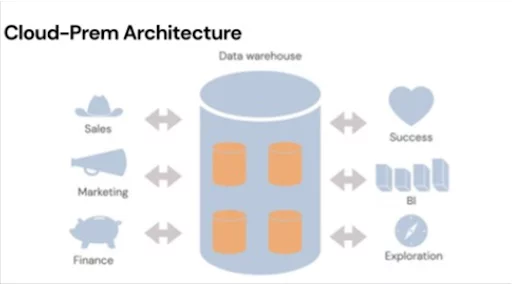In the world of data engineering, the future is happening faster than ever. As businesses become more data-driven and tech-savvy, data engineers are tasked with creating more efficient systems to store, manage, and analyze the vast amounts of data that are generated.
As we look ahead to 2023, a number of predictions can be made about the future of data engineering. From the rise of artificial intelligence and machine learning to the increased use of cloud computing and data virtualization, data engineers will need to stay ahead of the curve to prepare for what lies ahead.
In this article, we explore 9 predictions of what to expect from data engineering in 2023 and the steps you can take to make sure you’re ready.
Prediction #1: Increased Use of Artificial Intelligence and Machine Learning
As data volumes and variety increase, the need for automation and AI becomes ever more pressing. So as data engineering continues to advance, we can expect AI and machine learning to become increasingly prevalent. AI solutions that can ingest and analyze vast amounts of data have become increasingly accessible to businesses.
We can expect this trend to continue and for data engineering to see a rise in the use of AI tools such as natural language processing and image recognition. In particular, we can expect to see an increased use of unsupervised machine learning (especially clustering) to help with data exploration. Unsupervised machine learning is particularly useful for uncovering insights from customer data, such as behaviors and preferences.
Prediction #2: Increased Use of Cloud Computing
Cloud computing has revolutionized the way businesses store and access data, with data engineers often choosing cloud computing as the best solution. The rise of cloud computing has made it more accessible than ever before. We can expect the trend of businesses using cloud computing to continue, and for data engineering to see an increase in the use of cloud-based solutions.
There are many advantages to using cloud computing in data engineering, including the fact that it is easy to scale, easy to manage, and accessible from anywhere. Data engineers can also integrate cloud-based solutions with existing systems to reduce friction and make data management easier. We can also expect to see an increase in the use of managed cloud services, which enable businesses to do away with the hassle of managing their own cloud infrastructure.
Prediction #3: Emergence of Data Virtualization
With the rise of data volumes and variety, the need to transform and transfer data between systems and formats becomes ever more pressing. We can expect to see the emergence of data virtualization, which will help businesses overcome this challenge.
Cloud-based data virtualization solutions enable organizations to integrate data across different systems by running it through a virtual “data translator”. This can be used to transform data into a common format and make it available across different systems, thereby facilitating data exchange.
Data virtualization solutions can also help with data governance by enabling organizations to store “virtual copies” of data. This makes it easier to track changes and manage access.
Prediction #4: Automation of Data Engineering Tasks
As data engineering becomes more complex and data volumes and variety increase, the need for automation becomes ever more pressing. We can expect to see automation become increasingly important across the board in data engineering.
Automation can be used in data extraction, data transformation, and data loading processes. It can also be used to automate the deployment of data engineering solutions.
For example, you can use a deployment automation platform to make sure your data engineering processes are up and running quickly and without fail. This is particularly useful for organizations experiencing sudden surges in data volumes.
Prediction #5: Emergence of Data Lakes and Data Warehouses
As organizations become more data-driven, they will collect and store more data across a variety of formats. We can expect to see the rise of data lakes and data warehouses as a response to this.
Data lakes are typically used to store unstructured data in its original format, whereas data warehouses are used to store structured data in a more organized way. Data lakes are an optimal solution when you need to quickly ingest large amounts of data, while data warehouses are typically used when you need to analyze and report on data.
Therefore, as organizations collect more data across a wider variety of formats, we can expect to see the rise of both data lakes and data warehouses to facilitate data management.
Prediction #6: Emergence of Data Science
As businesses become more data-driven, the need for data scientists becomes increasingly important. In particular, data science is needed to make sense of the vast amounts of unstructured data that are being generated.
As the need for data science grows, we can expect to see data engineering become increasingly intertwined with data science. We can expect to see data engineering and data science workflows to become more integrated, with data engineers creating the most effective workflows to support data scientists. At the same time, we can expect to see data scientists become more involved in data engineering tasks.
This will enable them to take greater ownership of the data engineering lifecycle and support the entire data team.
Prediction #7: Increased Use of Streaming Data
As data volumes grow and become more unstructured, businesses will increasingly rely on streaming data (i.e. data that is generated in real-time). We can expect to see the growing importance of streaming data in data engineering.
Streaming data can be used to generate insights about things like customers’ behaviors and preferences, product health and usage, and supply chains. It can also be used to identify anomalies, predict outcomes, and prevent problems.
Prediction #8: Emergence of Data Governance
As organizations increase their focus on data engineering and data-driven decision-making, the need for data governance becomes increasingly important. We can expect to see data governance become an increasingly important aspect of data engineering.
Although data governance has been around for some time, it is set to become more crucial as businesses handle more data in more complex ways.
Data governance can help to ensure that organizations are dealing with their data in the most effective way possible. It can also help to ensure that data remains secure and compliant. We can expect to see data engineering become increasingly intertwined with data governance as organizations transfer more data between systems and formats.
Prediction #9: Emergence of DataOps
As data grows and becomes more complex, the need for collaborative teamwork becomes increasingly important. We can expect to see this need drive the emergence of dataOps, which is the term given to a data engineering team that is responsible for both the engineering and the operation of a data solution.
This is useful for organizations that are experiencing sudden surges in data volumes and need to quickly adapt their data engineering services to deal with the extra data. While data engineering is still a crucial part of data science, it is much more than just wrangling data. The role of data science is to understand the data, make sense of it, and then use it to create insights. Data engineering is the process of collecting and storing the data science uses; it is the plumbing behind the scenes.
Conclusion:
Data engineering is constantly evolving, and businesses and organizations will continue to use data-driven technologies and practices to manage the ever-growing amount of data that they have. We explore 9 predictions of what to expect from data engineering in 2023 and the steps you can take to make sure you’re ready. These trends are particularly likely to impact data engineering in the coming years and we hope that this article has provided you with some food for thought about what to expect from data engineering in the next 10 years.















